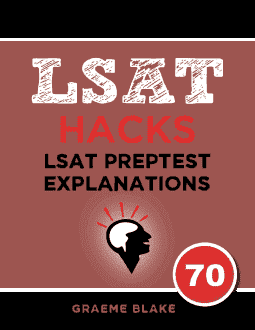This is an explanation of the first logic game from Section III of LSAT 70, the October 2013 LSAT.
A concert promoter is arranging six bands to play in a benefit concert: Uneasy, Vegemite, Wellspring, Xpert, Yardsign, Zircon (U, V, W, X, Y, Z). You must place them in order.
This is a linear game, with a few twists. It’s not a particularly difficult game. Nonetheless, it’s worth noting that all of the game types are becoming less standard.
The LSAC is aware that people are prepping more intensely, so they’re reducing the number of games that can be learned from a strategy guide.
To get better at non-standard games, you should repeat them. This way you’ll develop an intuition for the underlying patterns on logic games, and you’ll be able to handle new, non-standard rules. It’s a good idea to repeat the game on your own before reading these explanations.
Now, for the setup. First, you hopefully know that linear diagrams should have a series of horizontal slots:
![]()
Next, this game has some pure sequencing rules. These often appear in linear games. Here’s the first rule:
![]()
Here’s the second rule:

The first two rules can and should be combined. Notice that Z is in both rules. You can join both diagrams together using Z:

Always watch for multiple rules that mention the same variable.
The third and fourth rules are fairly rare. They say that U must be in the final three spots, and Y must be in the first three.
You could just write these in your list of rules, marking something like “U = last 3”. Or you could draw a “Not U” symbol under slots 1-3.
I think both of those methods add visual clutter without clarity. I do use “not” rules, but not when six of them are required to represent two rules. Instead, here’s how I drew these rules:

Notice that this diagram is both clear and minimal. Y goes somewhere in the first three and U goes somewhere in the final three.
One glance at the main diagram is enough to remind you of exactly what the rules say. I also find this helps me visualize where Y and U can go.
You should always check for deductions before starting. Look for restricted points. The main deduction is that only U or X can go last.
Y must go in the first three spaces, and V, Z and W must go before X. So only U or X are left to go sixth. You could draw this on the diagram:

However, I would only do this if you’re prone to forgetting this type of deduction. If you’re an advanced student of logic games, this type of deduction is likely second nature to you.
It might be worth adding Y – X on your ordering diagram. X has three variables before it, so X can’t go in the first three spaces. However, I haven’t drawn this on mine, as it’s easy for me to see this.


Thanks both of you, fixed it!
Hi Graeme!
Thank you so much for your guide on the Lsat. It is an invaluable resource. Now, I noticed the diagram for the first logic game in test 70 has a slight error in it. The finished sketch says the last two variables can either be V/X. I could be wrong, but I believe you meant to say that those two variables will either be U/X.
Thanks again,
Ray
It isn’t a huge deal but on the step that you say U or X could go last and you mark spot 6 with U/X, you actually marked it V/X.